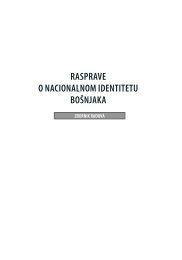- Page 1 and 2:
UDC 93/99 (058) ISSN 0350 1159 INST
- Page 3 and 4:
UDC 93/99 (058) ISSN 0350 1159 Pril
- Page 5 and 6:
UDC 93/99 (058) ISSN 0350 1159 Pril
- Page 7:
Riječ redakcije Prilozi, 36, Saraj
- Page 11 and 12:
Esad Kurtović, Prilog historiji vl
- Page 13 and 14:
Esad Kurtović, Prilog historiji vl
- Page 15 and 16:
Esad Kurtović, Prilog historiji vl
- Page 17 and 18:
Esad Kurtović, Prilog historiji vl
- Page 19 and 20:
Esad Kurtović, Prilog historiji vl
- Page 21 and 22:
Esad Kurtović, Prilog historiji vl
- Page 23 and 24:
Esad Kurtović, Prilog historiji vl
- Page 25 and 26:
Esad Kurtović, Prilog historiji vl
- Page 27 and 28:
Esad Kurtović, Prilog historiji vl
- Page 29 and 30:
Esad Kurtović, Prilog historiji vl
- Page 31:
Esad Kurtović, Prilog historiji vl
- Page 34 and 35:
Hana Younis, Skice porodičnog živ
- Page 36 and 37:
Hana Younis, Skice porodičnog živ
- Page 38 and 39:
Hana Younis, Skice porodičnog živ
- Page 40 and 41:
Hana Younis, Skice porodičnog živ
- Page 42 and 43:
Hana Younis, Skice porodičnog živ
- Page 44 and 45:
Hana Younis, Skice porodičnog živ
- Page 46 and 47:
Hana Younis, Skice porodičnog živ
- Page 48 and 49:
Hana Younis, Skice porodičnog živ
- Page 50 and 51:
Hana Younis, Skice porodičnog živ
- Page 52 and 53:
Hana Younis, Skice porodičnog živ
- Page 54 and 55:
Hana Younis, Skice porodičnog živ
- Page 56 and 57:
Hana Younis, Skice porodičnog živ
- Page 58 and 59:
Hana Younis, Skice porodičnog živ
- Page 60 and 61:
Hana Younis, Skice porodičnog živ
- Page 62 and 63:
Hana Younis, Skice porodičnog živ
- Page 64 and 65:
Hana Younis, Skice porodičnog živ
- Page 66 and 67:
Hana Younis, Skice porodičnog živ
- Page 68 and 69:
Hana Younis, Skice porodičnog živ
- Page 70 and 71:
Željko Karaula, Hrvatska (Republik
- Page 72 and 73:
Željko Karaula, Hrvatska (Republik
- Page 74 and 75:
Željko Karaula, Hrvatska (Republik
- Page 76 and 77:
Željko Karaula, Hrvatska (Republik
- Page 78 and 79:
Željko Karaula, Hrvatska (Republik
- Page 80 and 81:
Željko Karaula, Hrvatska (Republik
- Page 82 and 83:
Željko Karaula, Hrvatska (Republik
- Page 84 and 85:
Željko Karaula, Hrvatska (Republik
- Page 86 and 87:
Željko Karaula, Hrvatska (Republik
- Page 88 and 89:
Željko Karaula, Hrvatska (Republik
- Page 90 and 91:
Željko Karaula, Hrvatska (Republik
- Page 92 and 93:
Željko Karaula, Hrvatska (Republik
- Page 94 and 95:
Željko Karaula, Hrvatska (Republik
- Page 96 and 97:
Željko Karaula, Hrvatska (Republik
- Page 98 and 99:
Adnan Velagić, Obnova i društveni
- Page 100 and 101:
Adnan Velagić, Obnova i društveni
- Page 102 and 103:
Adnan Velagić, Obnova i društveni
- Page 104 and 105:
Adnan Velagić, Obnova i društveni
- Page 106 and 107:
Adnan Velagić, Obnova i društveni
- Page 108 and 109:
Adnan Velagić, Obnova i društveni
- Page 110 and 111:
Adnan Velagić, Obnova i društveni
- Page 112 and 113:
Adnan Velagić, Obnova i društveni
- Page 114 and 115:
Adnan Velagić, Obnova i društveni
- Page 116 and 117:
Adnan Velagić, Obnova i društveni
- Page 118 and 119:
Adnan Velagić, Obnova i društveni
- Page 120 and 121:
Tomislav Išek, Koncepcije osnivač
- Page 122 and 123:
Tomislav Išek, Koncepcije osnivač
- Page 124 and 125:
Tomislav Išek, Koncepcije osnivač
- Page 126 and 127:
Tomislav Išek, Koncepcije osnivač
- Page 128 and 129: Tomislav Išek, Koncepcije osnivač
- Page 130 and 131: Tomislav Išek, Koncepcije osnivač
- Page 132 and 133: Tomislav Išek, Koncepcije osnivač
- Page 135 and 136: Iljas Hadžibegović, Socijalna str
- Page 137 and 138: Iljas Hadžibegović, Socijalna str
- Page 139 and 140: Iljas Hadžibegović, Socijalna str
- Page 141 and 142: Iljas Hadžibegović, Socijalna str
- Page 143 and 144: Iljas Hadžibegović, Socijalna str
- Page 145 and 146: Iljas Hadžibegović, Socijalna str
- Page 147 and 148: Iljas Hadžibegović, Socijalna str
- Page 149 and 150: Iljas Hadžibegović, Socijalna str
- Page 151 and 152: Iljas Hadžibegović, Socijalna str
- Page 153 and 154: Iljas Hadžibegović, Socijalna str
- Page 155 and 156: Iljas Hadžibegović, Socijalna str
- Page 157 and 158: Iljas Hadžibegović, Socijalna str
- Page 159 and 160: Iljas Hadžibegović, Socijalna str
- Page 161 and 162: Iljas Hadžibegović, Socijalna str
- Page 163 and 164: Iljas Hadžibegović, Socijalna str
- Page 165 and 166: Iljas Hadžibegović, Socijalna str
- Page 167 and 168: Iljas Hadžibegović, Socijalna str
- Page 169 and 170: Iljas Hadžibegović, Socijalna str
- Page 171 and 172: Iljas Hadžibegović, Socijalna str
- Page 173 and 174: Iljas Hadžibegović, Socijalna str
- Page 175 and 176: Iljas Hadžibegović, Socijalna str
- Page 177: Iljas Hadžibegović, Socijalna str
- Page 182 and 183: Mina Kujović, Prepiska iz 1941. i
- Page 184 and 185: Mina Kujović, Prepiska iz 1941. i
- Page 186 and 187: Mina Kujović, Prepiska iz 1941. i
- Page 188 and 189: Mina Kujović, Prepiska iz 1941. i
- Page 191: IZLAGANJA SA NUČNIH SKUPOVA
- Page 194 and 195: Edin Radušić, Stav Islamske zajed
- Page 196 and 197: Edin Radušić, Stav Islamske zajed
- Page 198 and 199: Edin Radušić, Stav Islamske zajed
- Page 200 and 201: Edin Radušić, Stav Islamske zajed
- Page 202 and 203: Edin Radušić, Stav Islamske zajed
- Page 204 and 205: Ibrahim Karabegović, Doprinos dr.
- Page 206 and 207: Ibrahim Karabegović, Doprinos dr.
- Page 209: PRIKAZI
- Page 212 and 213: Prikazi Prilozi, 36, Sarajevo, 2007
- Page 214 and 215: Prikazi Prilozi, 36, Sarajevo, 2007
- Page 216 and 217: Prikazi Prilozi, 36, Sarajevo, 2007
- Page 218 and 219: Prikazi Prilozi, 36, Sarajevo, 2007
- Page 220 and 221: Prikazi Prilozi, 36, Sarajevo, 2007
- Page 222 and 223: Prikazi Prilozi, 36, Sarajevo, 2007
- Page 224 and 225: Prikazi Prilozi, 36, Sarajevo, 2007
- Page 226 and 227: Prikazi Prilozi, 36, Sarajevo, 2007
- Page 228 and 229:
Prikazi Prilozi, 36, Sarajevo, 2007
- Page 230 and 231:
Prikazi Prilozi, 36, Sarajevo, 2007
- Page 232 and 233:
Prikazi Prilozi, 36, Sarajevo, 2007
- Page 234 and 235:
Prikazi Prilozi, 36, Sarajevo, 2007
- Page 236 and 237:
Prikazi Prilozi, 36, Sarajevo, 2007
- Page 238 and 239:
Prikazi Prilozi, 36, Sarajevo, 2007
- Page 240 and 241:
Prikazi Prilozi, 36, Sarajevo, 2007
- Page 242 and 243:
Prikazi Prilozi, 36, Sarajevo, 2007
- Page 244 and 245:
Prikazi Prilozi, 36, Sarajevo, 2007
- Page 246 and 247:
Prikazi Prilozi, 36, Sarajevo, 2007
- Page 248 and 249:
Prikazi Prilozi, 36, Sarajevo, 2007
- Page 250 and 251:
Prikazi Prilozi, 36, Sarajevo, 2007
- Page 252 and 253:
Prikazi Prilozi, 36, Sarajevo, 2007
- Page 254 and 255:
Prikazi Prilozi, 36, Sarajevo, 2007
- Page 256 and 257:
Prikazi Prilozi, 36, Sarajevo, 2007
- Page 258 and 259:
Prikazi Prilozi, 36, Sarajevo, 2007
- Page 260 and 261:
Prikazi Prilozi, 36, Sarajevo, 2007
- Page 262 and 263:
Prikazi Prilozi, 36, Sarajevo, 2007
- Page 264 and 265:
Prikazi Prilozi, 36, Sarajevo, 2007
- Page 266 and 267:
Prikazi Prilozi, 36, Sarajevo, 2007
- Page 268 and 269:
Prikazi Prilozi, 36, Sarajevo, 2007
- Page 270 and 271:
Prikazi Prilozi, 36, Sarajevo, 2007
- Page 272 and 273:
Prikazi Prilozi, 36, Sarajevo, 2007
- Page 274 and 275:
Prikazi Prilozi, 36, Sarajevo, 2007
- Page 276 and 277:
Prikazi Prilozi, 36, Sarajevo, 2007
- Page 278 and 279:
Prikazi Prilozi, 36, Sarajevo, 2007
- Page 280 and 281:
Prikazi Prilozi, 36, Sarajevo, 2007
- Page 282 and 283:
Prikazi Prilozi, 36, Sarajevo, 2007
- Page 284 and 285:
Prikazi Prilozi, 36, Sarajevo, 2007
- Page 286 and 287:
Prikazi Prilozi, 36, Sarajevo, 2007
- Page 288 and 289:
Prikazi Prilozi, 36, Sarajevo, 2007
- Page 290 and 291:
Prikazi Prilozi, 36, Sarajevo, 2007
- Page 292 and 293:
Prikazi Prilozi, 36, Sarajevo, 2007
- Page 294 and 295:
Prikazi Prilozi, 36, Sarajevo, 2007
- Page 296 and 297:
Prikazi Prilozi, 36, Sarajevo, 2007
- Page 298 and 299:
Prikazi Prilozi, 36, Sarajevo, 2007
- Page 300 and 301:
Prikazi Prilozi, 36, Sarajevo, 2007
- Page 302 and 303:
Prikazi Prilozi, 36, Sarajevo, 2007
- Page 305 and 306:
Indeks autora Prilozi, 36, Sarajevo
- Page 307 and 308:
Upute sradnicima Prilozi, 36, Saraj
- Page 309 and 310:
KATALOG IZDANJA INSTITUTA ZA ISTORI
- Page 311 and 312:
KATALOG IZDANJA INSTITUTA ZA ISTORI
- Page 313 and 314:
KATALOG IZDANJA INSTITUTA ZA ISTORI
- Page 315 and 316:
KATALOG IZDANJA INSTITUTA ZA ISTORI
- Page 317 and 318:
KATALOG IZDANJA INSTITUTA ZA ISTORI
- Page 320:
PRILOZI INSTITUT ZA ISTORIJU U SARA






